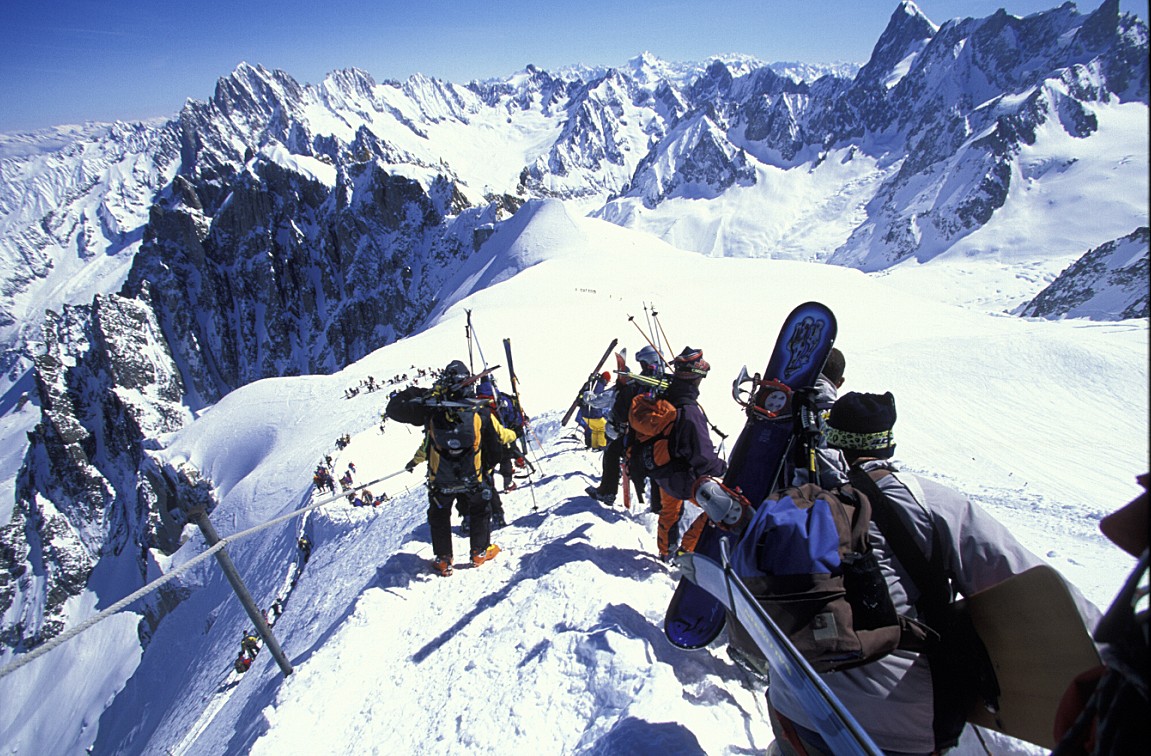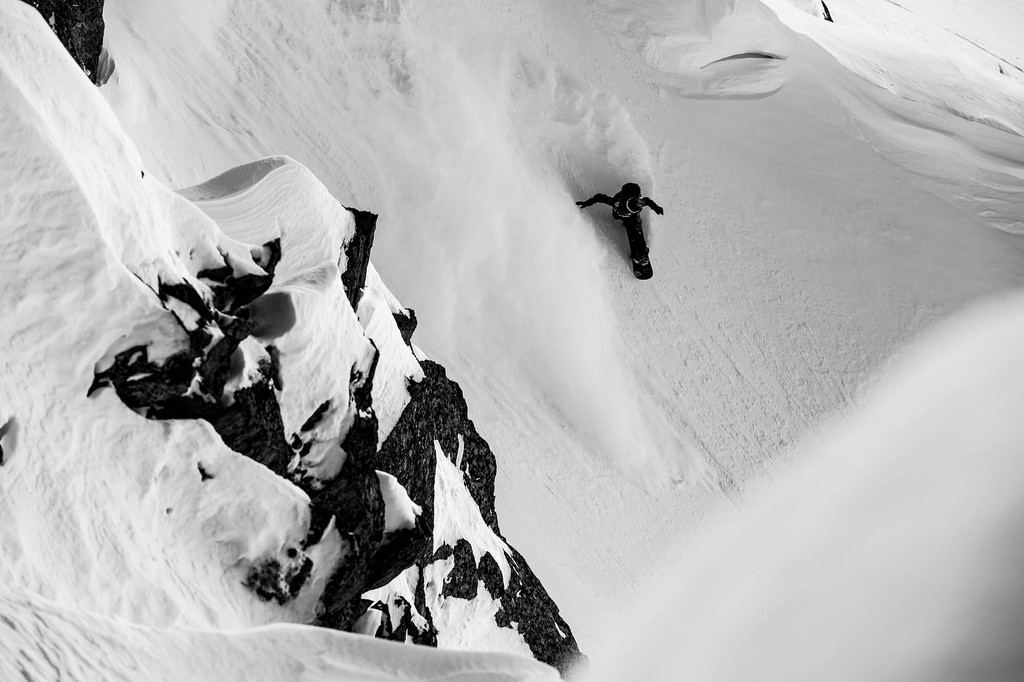Freeriding in Chamonix is world famous. Skiing Mont Blanc offers some of the finest freeride runs you can imagine, straight from the ski lift with exceptional mountain scenery.
OnTheSnow spoke to Yan Raulet, a mountain guide for 25 years, about freeriding in Chamonix. Raulet recommends two days to explore two major areas of off-piste skiing in the Chamonix valley: the Grands Montets and the Aiguilles du Midi, with an overnight stay where you can enjoy the atmosphere of a mountain refuge.
Best routes for freeriding in Chamonix
Raulet advises starting on the Grands Montets (3,300m). There you can ski the Argentière glacier and the many off-piste routes down to Chamonix, which you can choose depending on how good you are. In the afternoon go up the Aiguilles du Midi (3,800m) on Europe’s highest ski lift and down the ridge to spend a night in the comfortable and hospitable Cosmique refuge.
From the Aiguille du Midi (3,842m) to Chamonix (1,030m), the Vallée Blanche is one of the most famous downhill off-piste runs. Start early and enjoy the beautiful first light on the mountains and at the same time avoid other skiers. The route stretches 20 kilometres – 18 kilometres of which is on three giant glaciers: the Géant, the Tacul and the Mer de Glace with beautiful views of the alpine peaks and Mont Blanc. You select the route with your guide depending on your ability, the quality of the snow and how energetic you are. Don’t forget that you are entirely off-piste and snow conditions can vary dramatically on a glacier.

Halfway down, you can take a break for a meal or picnic at the Requin refuge (2,516 m) with a fine view of the crevasses on the Géant glacier. Several routes are possible assuming you can handle a red run comfortably and conditions in the Vallée Blanche are good. The easiest is the original ‘classique’ route, avoiding all the steep bits of the glacier, in the heart of the Mont Blanc skiing area, with magnificent views of the Alps: the Monte Rosa, the Matterhorn, Switzerland, Italy, Les Drus and the Grandes Jorasses.
Freeriding in Chamonix highlights
The Gross Rognon – which translates to the Big Kidney – is an alternative route. Just to the left of it, the route is less visited and often you can ski in deep virgin snow. It is also an excellent opportunity to test your skills in deep snow because you can easily rejoin the ‘classique’ route whenever you want to.
The Envers du Plan is a steeper and more difficult route that takes you between the crevasses on a wilder part of the glacier du Géant. It is one of the best routes for good backcountry skiers with many possible variants.
On the Grand Envers, the skiing is difficult. The route has some steep slopes averaging 40 to 45 degrees. To take this route you will need first-class skills and perfect control of your skis. It is a great experience for the best skiers.
Don’t forget though that the Vallée Blanche is not a ski slope but an unmarked high mountain route. The form of the glaciers changes all the time, cracks can open up from day to day and depending on the state of the snow and the glacier there is always the risk of avalanches or falling ice. The weather dictates the quality of the snow.

Snowboarders
What about freeriding in Chamonix for snowboarders? Raulet says, “The Vallée Blanche is not a route that is ideally suited to snowboarding, but those who are fit and have good technical ability often do it from the Aiguilles du Midi. The route includes some steep sections and traverses where you need to lose as little height as little as possible to avoid the crevasses. Then there are certain relatively level parts where you have to retain speed and at the same time be aware of the terrain to avoid the crevasses. You should treat your board with the correct wax for the temperature and humidity of the snow and use telescopic ski sticks for the level areas and for the traversing slopes.”
Heliskiing
Helicopter ski drops are not allowed in Chamonix however there are two areas you can reach easily. You can drive to the Aiguille du Tour In Switzerland in 30 minutes via the Mont Blanc tunnel. From a single drop there are many possible routes. On average, each route involves a descent of 2,000 m on slopes of 30° to 45 °.
In Italy, you can reach Courmayeur in 20 minutes. The Italian side of Mont Blanc has several dropping points at 3,800 or even 4,200 meters. There are two possible routes for expert skiers.
Getting back to the village of Courmayeur involves an hour of trekking using ski sticks. Alternatively you can make a final drop on the mountains facing Mont Blanc. Heliski drops can link up easily with off-piste skiing from Chamonix in the Vallée Blanche and the Grands Montets
Your guide will advise you on the logistics. Prepare to pay at least €500 per drop for four people, guide not included, but the experience is unforgettable.
Finding a guide
When freeriding in Chamonix, finding a guide is crucial and nothing beats word of mouth recommendations. Failing that there are several organizations to advise you.
Yan Raulet runs Chamonixskiguide.com and is also a member of the International Association of Mont Blanc guides open to foreigners – English, German etc. The best known organisation is the Compagnie des Guides de Chamonix.
The Chamonix Tourist Office and the Office de Haute Montagne are always available to advise you.
Fees for the guide depend on what you want to do and are shared by the number of clients. Expect to pay at least €300 per day. In addition, you will pay for your food, meals, lifts, lodging and equipment rental. Traditionally you pay for meals and accommodation for your guide.
As far as safety is concerned, the guide makes the key decisions. If conditions are too bad, everything could be cancelled and payment refunded. Alternatively, the guide may propose a less risky alternative.
Geneva Airport is the closest to Chamonix.




